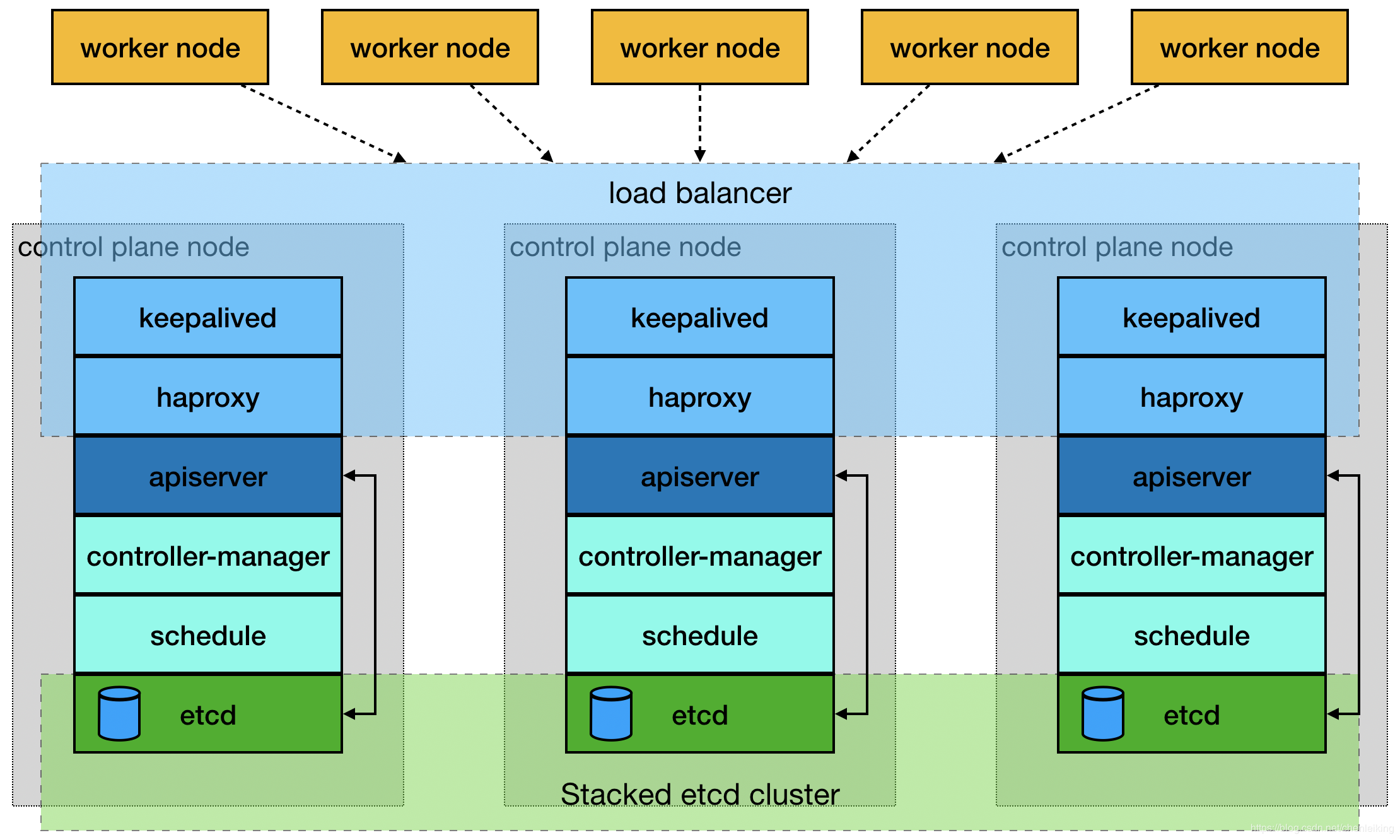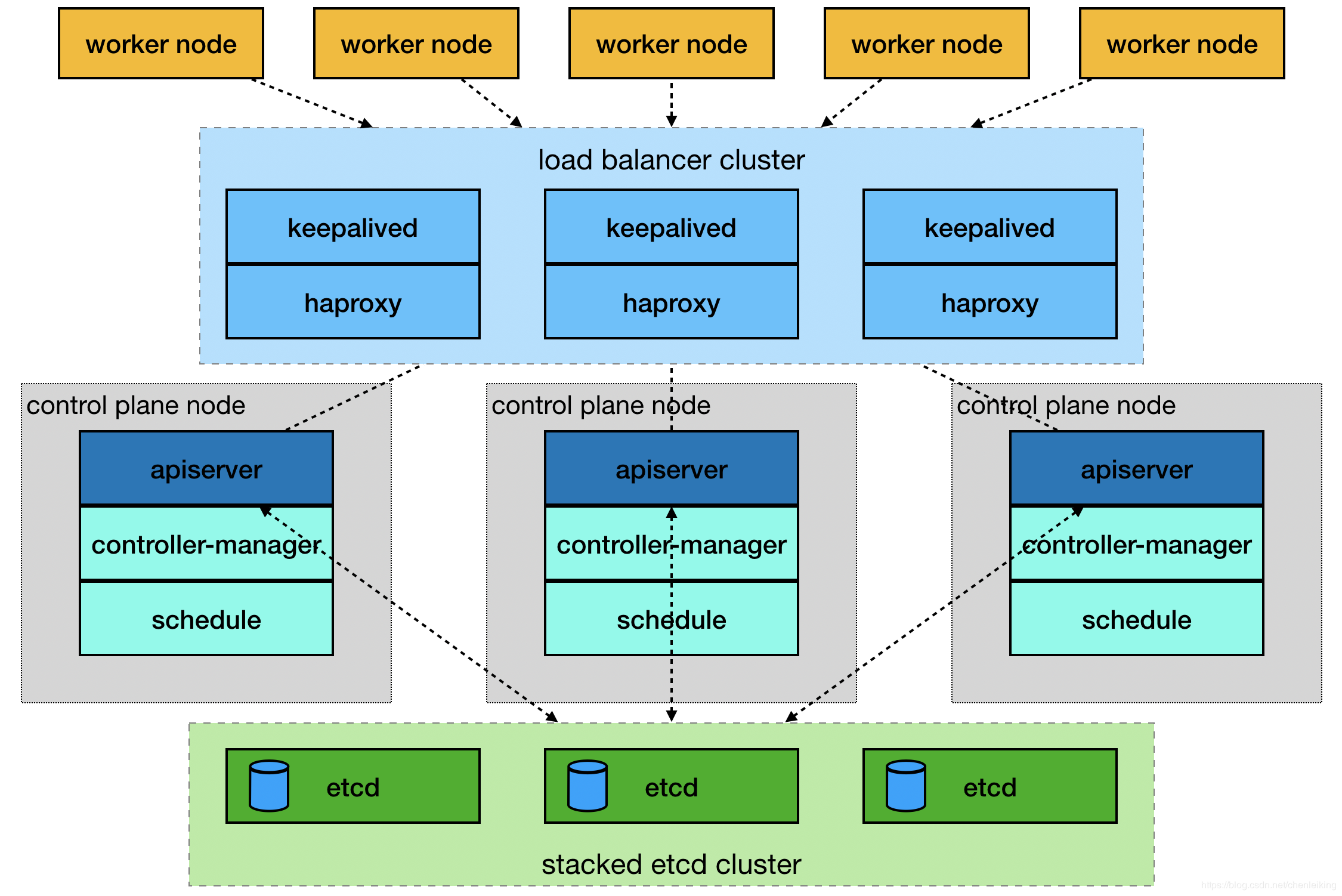序
由于单master节点的kubernetes集群,存在master节点异常之后无法继续使用的缺陷。本文参考网管流程搭建一套多master节点负载均衡的kubernetes集群。官网给出了两种拓扑结构:堆叠control plane node和external etcd node,本文基于第一种拓扑结构进行搭建,使用keepalived + haproxy搭建,完整的拓扑图如下:

(堆叠control plane node)

(external etcd node)
mastre节点需要部署etcd、apiserver、controller-manager、schedule这4种服务,其中etcd、ntroller-manager、schedule这三种服务kubernetes自身已经实现了高可用,在多master节点的情况下,每个master节点都会启动这三种服务器,同一时间只有一个生效。因此要实现kubernetes的高可用,只需要apiserver服务高可用。
keepalived是一种高性能的服务器高可用或热备解决方案,可以用来防止服务器单点故障导致服务中断的问题。keepalived使用主备模式,至少需要两台服务器才能正常工作。比如keepalived将三台服务器搭建成一个集群,对外提供一个唯一IP,正常情况下只有一台服务器上可以看到这个IP的虚拟网卡。如果这台服务异常,那么keepalived会立即将IP移动到剩下的两台服务器中的一台上,使得IP可以正常使用。
haproxy是一款提供高可用性、负载均衡以及基于TCP(第四层)和HTTP(第七层)应用的代理软件,支持虚拟主机,它是免费、快速并且可靠的一种解决方案。使用haproxy负载均衡后端的apiserver服务,达到apiserver服务高可用的目的。
本文使用的keepalived+haproxy方案,使用keepalived对外提供稳定的入口,使用haproxy对内均衡负载。因为haproxy运行在master节点上,当master节点异常后,haproxy服务也会停止,为了避免这种情况,我们在每一台master节点都部署haproxy服务,达到haproxy服务高可用的目的。由于多master节点会出现投票竞选的问题,因此master节点的数据最好是单数,避免票数相同的情况。
搭建环境
第一步:环境说明
192.168.1.13 master-01 192.168.1.14 master-02 192.168.1.15 master-03 192.168.1.16 node-01
第二步:关闭防火墙等(all)
# 1.关闭防火墙 systemctl stop firewalld && systemctl disable firewalld # 2.关闭selinux setenforce 0 vim /etc/selinux/config SELINUX=enforcing改为SELINUX=disabled,保存后退出 # 3.关闭交换分区 swapoff -a sed -i 's/.*swap.*/#&/' /etc/fstab # 4.iptables设置 iptables -P FORWARD ACCEPT
第三步:安装docker(all)
# 1.安装
yum install docker -y
# 2.启动和默认启动
systemctl start docker && systemctl enable docker
# 3.配置
cat > /etc/docker/daemon.json << EOF
{
"registry-mirrors": ["https://阿里个人加速网址.mirror.aliyuncs.com"],
"exec-opts":["native.cgroupdriver=systemd"],
"graph": "/new-path/docker" # 该路径必须存在
}
EOF
第四步:启动docker时配置iptables(all)
vim /etc/systemd/system/docker.service [Service]下面添加 ExecStartPost=/sbin/iptables -I FORWARD -s 0.0.0.0/0 -j ACCEPT
第五步:设置host(all)
# 在不同的服务器上运行 hostnamectl set-hostname master-01 hostnamectl set-hostname master-02 hostnamectl set-hostname master-03 hostnamectl set-hostname node-01 # 所有的服务器都运行 cat >> /etc/hosts << EOF 192.168.1.13 master-01 192.168.1.14 master-02 192.168.1.15 master-03 192.168.1.16 node-01 EOF
第六步:设置yum源(all)
cat > /etc/yum.repos.d/docker.repo <<EOF [docker-repo] name=Docker Repository baseurl=http://mirrors.aliyun.com/docker-engine/yum/repo/main/centos/7 enabled=1 gpgcheck=0 EOF cat > /etc/sysctl.d/k8s.conf << EOF net.bridge.bridge-nf-call-ip6tables = 1 net.bridge.bridge-nf-call-iptables = 1 net.ipv4.ip_forward = 1 EOF cat > /etc/yum.repos.d/kubernetes.repo << EOF [kubernetes] name=Kubernetes baseurl=http://mirrors.aliyun.com/kubernetes/yum/repos/kubernetes-el7-x86_64 enabled=1 gpgcheck=0 repo_gpgcheck=0 gpgkey=http://mirrors.aliyun.com/kubernetes/yum/doc/yum-key.gpg http://mirrors.aliyun.com/kubernetes/yum/doc/rpm-package-key.gpg EOF
第七步:安装keepalived(master)
# 1. 安装yum
yum install -y keepalived
# 2.备份配置文件
cp /etc/keepalived/keepalived.conf /etc/keepalived/keepalived.conf-back
# 3.编辑配置文件
cat > /etc/keepalived/keepalived.conf << EOF
! Configuration File for keepalived
global_defs {
router_id LVS_DEVEL
}
vrrp_script check_haproxy {
script "killall -0 haproxy"
interval 3
weight -2
fall 10
rise 2
}
vrrp_instance VI_1 {
state MASTER
interface ens33 # 虚拟网卡桥接的真实网卡
virtual_router_id 51
# 优先级配置,每台服务器最好都不一样,如100,90,80等,优先级越高越先使用
priority 90
advert_int 1
authentication {
auth_type PASS
auth_pass 111
}
virtual_ipaddress {
192.168.1.200 # 对外提供的虚拟IP
}
track_script {
check_haproxy
}
}
EOF
# 4.启动
systemctl start keepalived && systemctl enable keepalived && systemctl status keepalived
说明:检查keepalived是否安装成功的标准是:1.任何一台服务器上ping虚拟ip可以通;2.虚拟IP只在一台服务上可见;3.任意停止某一台服务器后,虚拟IP会移动到剩下的某一台服务器上,并正常使用。
第九步:安装haproxy(master)
# 1.安装
yum install -y haproxy
# 2.备份配置文件
cp /etc/haproxy/haproxy.cfg /etc/haproxy/haproxy.cfg-back
# 3.编辑配置文件
cat > /etc/haproxy/haproxy.cfg << EOF
#---------------------------------------------------------------------
# Global settings
#---------------------------------------------------------------------
global
# to have these messages end up in /var/log/haproxy.log you will
# need to:
#
# 1) configure syslog to accept network log events. This is done
# by adding the '-r' option to the SYSLOGD_OPTIONS in
# /etc/sysconfig/syslog
#
# 2) configure local2 events to go to the /var/log/haproxy.log
# file. A line like the following can be added to
# /etc/sysconfig/syslog
#
# local2.* /var/log/haproxy.log
#
log 127.0.0.1 local2
chroot /var/lib/haproxy
pidfile /var/run/haproxy.pid
maxconn 4000
user haproxy
group haproxy
daemon
# turn on stats unix socket
stats socket /var/lib/haproxy/stats
#---------------------------------------------------------------------
# common defaults that all the 'listen' and 'backend' sections will
# use if not designated in their block
#---------------------------------------------------------------------
defaults
mode http
log global
option httplog
option dontlognull
option http-server-close
option forwardfor except 127.0.0.0/8
option redispatch
retries 3
timeout http-request 10s
timeout queue 1m
timeout connect 10s
timeout client 1m
timeout server 1m
timeout http-keep-alive 10s
timeout check 10s
maxconn 3000
#---------------------------------------------------------------------
# kubernetes apiserver frontend which proxys to the backends
#---------------------------------------------------------------------
frontend kubernetes-apiserver
mode tcp
bind *:6444 # 对外提供服务的端口,必须和kubernetes一致
option tcplog
default_backend kubernetes-apiserver #后端服务的名称
#---------------------------------------------------------------------
# round robin balancing between the various backends
#---------------------------------------------------------------------
backend kubernetes-apiserver
mode tcp
balance roundrobin
server master-01 192.168.1.13:6443 check # 后端服务器hostname和IP
server master-02 192.168.1.14:6443 check # 后端服务器hostname和IP
server master-03 192.168.1.15:6443 check # 后端服务器hostname和IP
EOF
# 4.启动
systemctl start haproxy && systemctl enable haproxy && systemctl status haproxy
第九步:安装kubelet kubeadm kubectl(all)
# 1.安装 yum install -y kubelet kubeadm kubectl #2.启动 systemctl enable kubelet && systemctl start kubelet
第十步:master节点初始化kubeadm配置文件(master)
# 1.导入默认的配置文件
kubeadm config print init-defaults > kubeadm-config.yaml
# 2.编辑配置文件
cat kubeadm-config.yaml
apiVersion: kubeadm.k8s.io/v1beta2
bootstrapTokens:
- groups:
- system:bootstrappers:kubeadm:default-node-token
token: abcdef.0123456789abcdef
ttl: 24h0m0s
usages:
- signing
- authentication
kind: InitConfiguration
localAPIEndpoint:
advertiseAddress: 192.168.1.13
bindPort: 6443
nodeRegistration:
criSocket: /var/run/dockershim.sock
name: master-01
taints:
- effect: NoSchedule
key: node-role.kubernetes.io/master
---
apiServer:
timeoutForControlPlane: 4m0s
apiVersion: kubeadm.k8s.io/v1beta2
certificatesDir: /etc/kubernetes/pki
clusterName: kubernetes
controlPlaneEndpoint: "192.168.1.200:6444" # IP要和keepalived一致 端口要和haproxy一致
controllerManager: {}
dns:
type: CoreDNS
etcd:
local:
dataDir: /var/lib/etcd
imageRepository: registry.aliyuncs.com/google_containers
kind: ClusterConfiguration
kubernetesVersion: v1.18.0
networking:
dnsDomain: cluster.local
podSubnet: 10.244.0.0/16 # flannel网络IP范围
serviceSubnet: 10.96.0.0/12
scheduler: {}
# 初始化
kubeadm init --config kubeadm-config.yaml
第十一步:安装flanner网络(all)
# 1.添加IP和hostname的对应关系 cat >> /etc/hosts << EOF 151.101.76.133 raw.githubusercontent.com EOF # 2.下载并启动flannel kubectl create -f https://raw.githubusercontent.com/coreos/flannel/master/Documentation/kube-flannel.yml
第十二步:添加master节点(master)
# 1.从master节点拷贝配置文件到准备添加的节点上
mkdir -p /etc/kubernetes/pki/etcd
scp /etc/kubernetes/admin.conf root@192.168.1.14:/etc/kubernetes/admin.conf
scp /etc/kubernetes/pki/{ca.*,sa.*,front-proxy-ca.*} root@192.168.1.14:/etc/kubernetes/pki
scp /etc/kubernetes/pki/etcd/ca.* root@192.168.1.14:/etc/kubernetes/pki/etcd
# 2.在master节点上初始化时,最后会打印两条命令,一条是添加master节点,一条是添加node节点,直接运行即可,如下是添加master节点:
kubeadm join 192.168.1.200:6444 --token abcdef.0123456789abcdef
--discovery-token-ca-cert-hash sha256:03e40218613fedde35123d1e0c81577d2f07285f7cda01000cf887ba17b2911f
--control-plane
# 3.join命令执行后,打印几条命令,同样需要执行,如下所示:
mkdir -p $HOME/.kube
sudo cp -i /etc/kubernetes/admin.conf $HOME/.kube/config
sudo chown $(id -u):$(id -g) $HOME/.kube/config
第十三步:添加node节点(node)
# 1.在master节点上初始化时,最后会打印两条命令,一条是添加master节点,一条是添加node节点,直接运行即可,如下是添加node节点:
kubeadm join 192.168.1.200:6444 --token abcdef.0123456789abcdef
--discovery-token-ca-cert-hash sha256:03e40218613fedde35123d1e0c81577d2f07285f7cda01000cf887ba17b2911f
第十四步:检查环节是否搭建成功
任意关闭一台master节点,然后查看集群是否可以正常工作。
第十五步:同步集群服务器时间
yum -y install ntp ntpdate #安装ntpdate时间同步工具 ntpdate cn.pool.ntp.org #设置时间同步 hwclock --systohc #将系统时间写入硬件时间 timedatectl #查看系统时间
结束
本次搭建的高可用kubernetes集群,版本是1.8,环境还在运行过程中,如有问题,欢迎一起讨论学习。